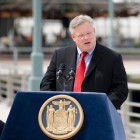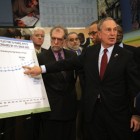The recession pushed an alarming number of New York City families, many of them with children, into homelessness in 2009, according to a new report by Citizen’s Committee for Children. The number of families applying to live in city homeless shelters increased about 27 percent to nearly 24,000 between 2008 and 2009, according to the annual report, Keeping Track of New York City’s Children .The trend mirrors the spike in adult street homelessness reported in March by the city’s Department of Homeless Services. Their annual one-night survey found a 25 percent year-over-year increase in the numbers of people living on the streets of New York, to about 3100 people.Keeping Track is a compendium of statistics describing the quality of life that New York City’s children enjoy. Many children enjoy little, the report notes.The number of children entering foster care declined almost every year between 1998 and 2008, the report shows, down more than half, to 16,200. And the city’s four-year high school graduation rate has steadily edged higher since 2005, increasing almost 10 percent.But several major problems persist, the report found:26 percent of all New York City children live in poverty.Children here are three times more likely to be hospitalized for preventable illnesses – such as asthma, pneumonia, and acute respiratory infections – than children in the rest of the state.The number of youth younger than 20 arrested on felony and misdemeanor charges was at a 12-year-high in 2008, with about 88,900 arrests.All indicators of child well-being in New York are worse among black and Latino children, the report found, with one of the greatest racial disparities being in the number of children born into poverty.








